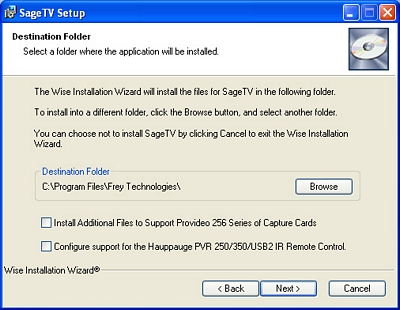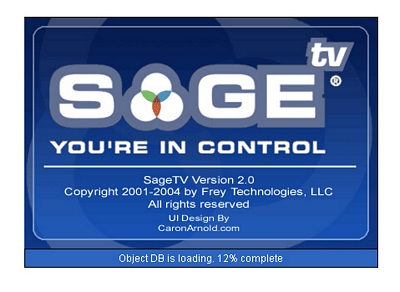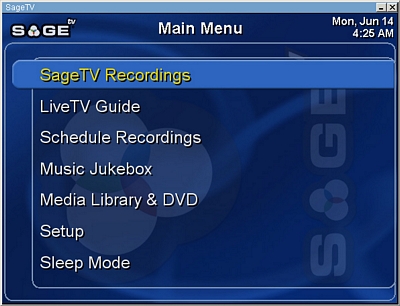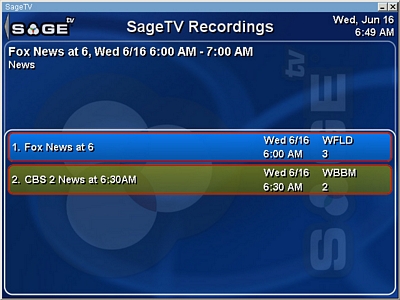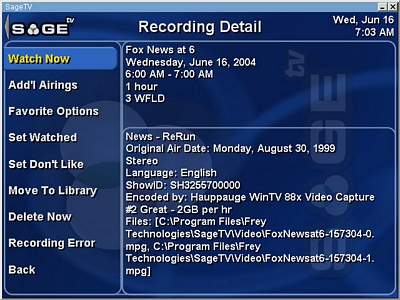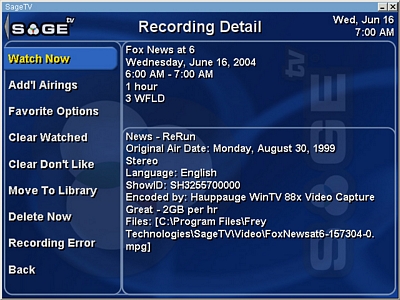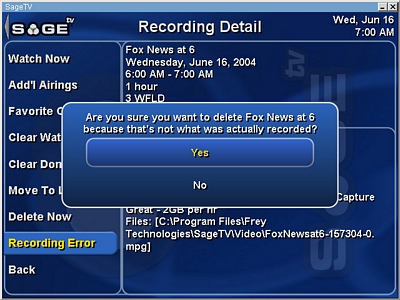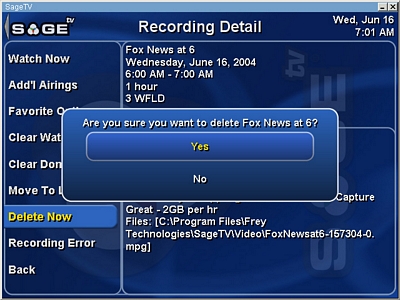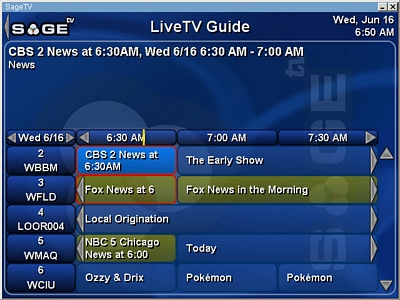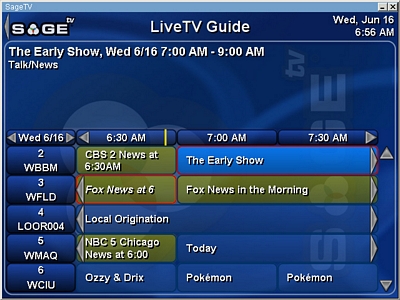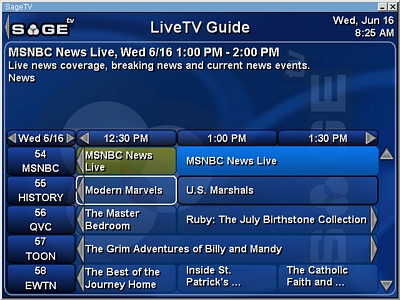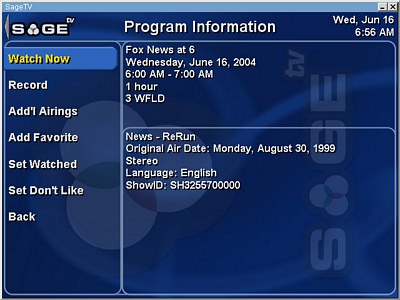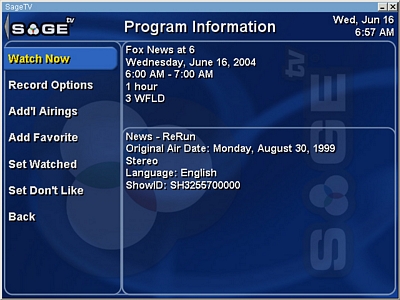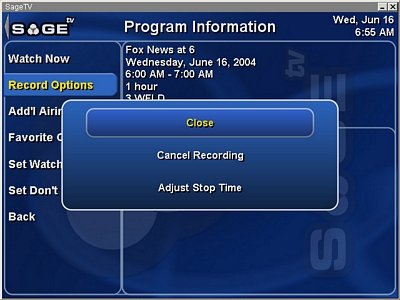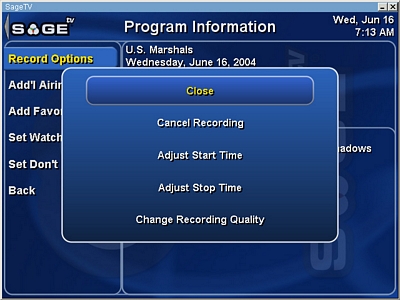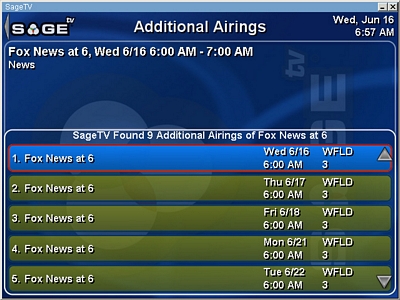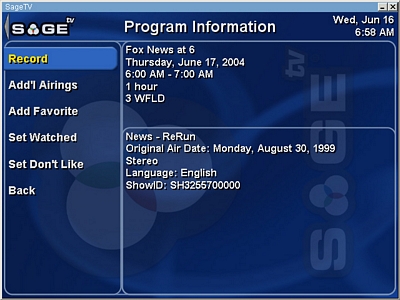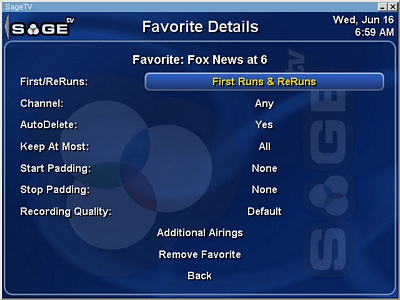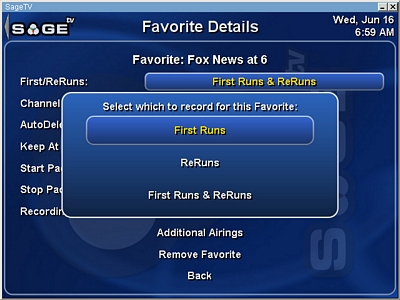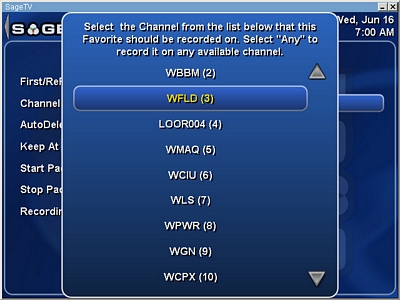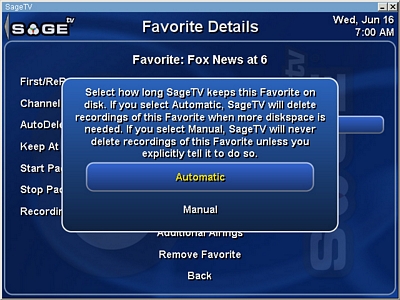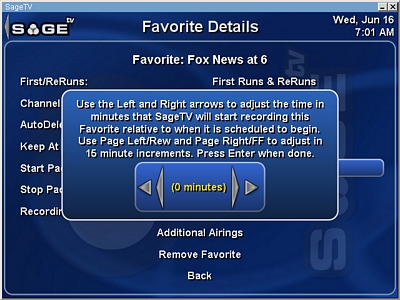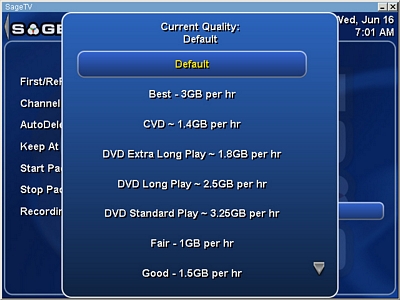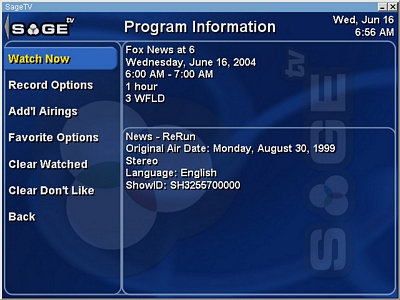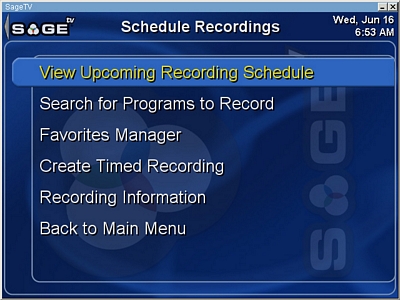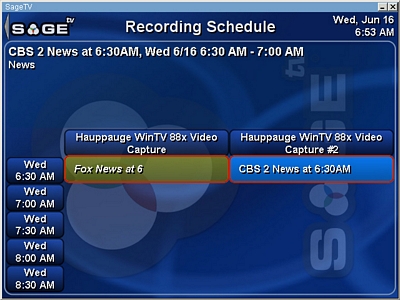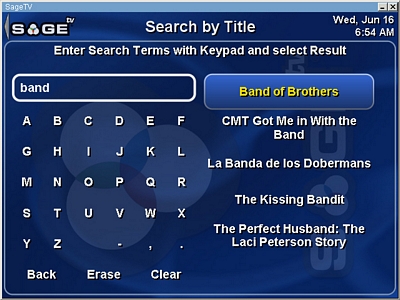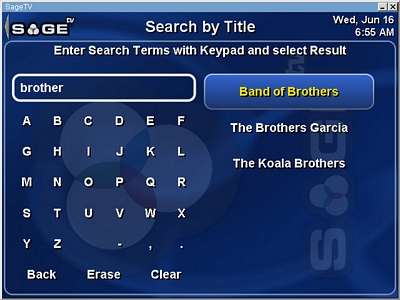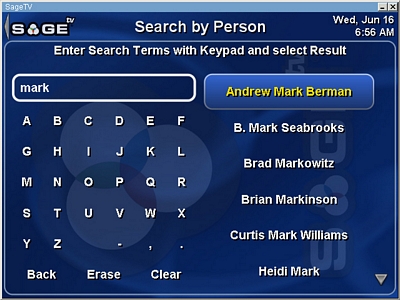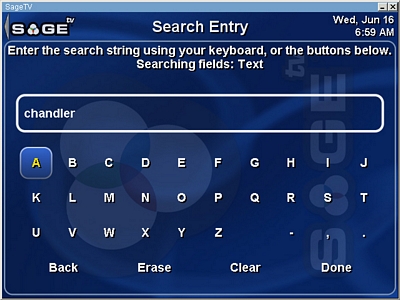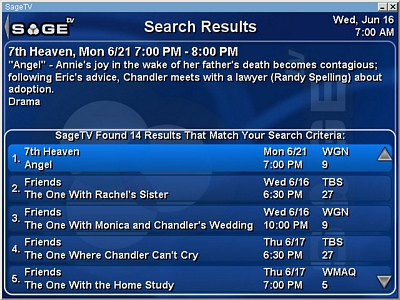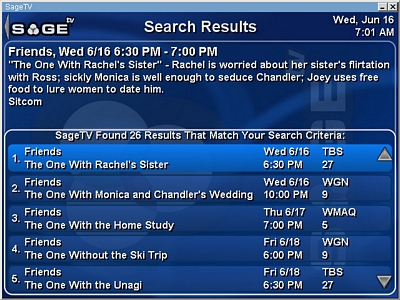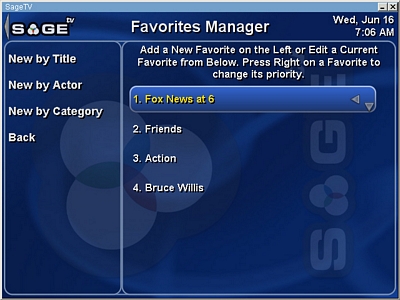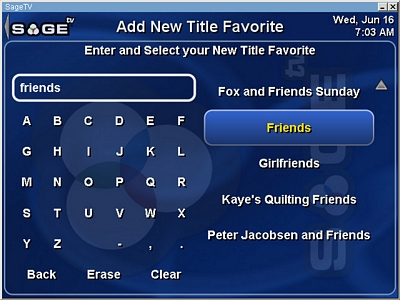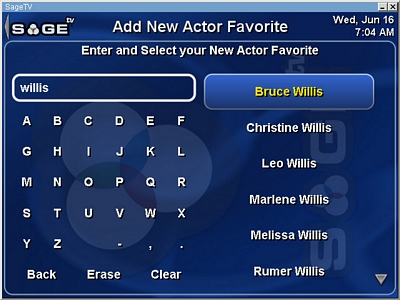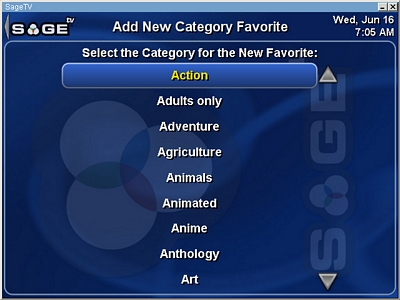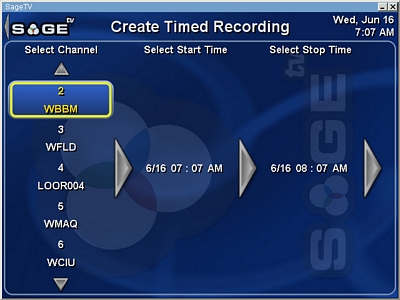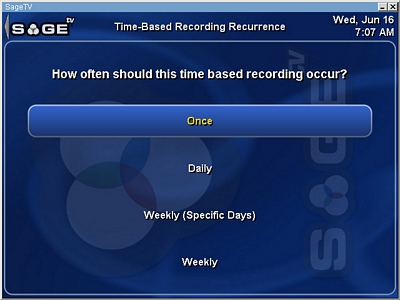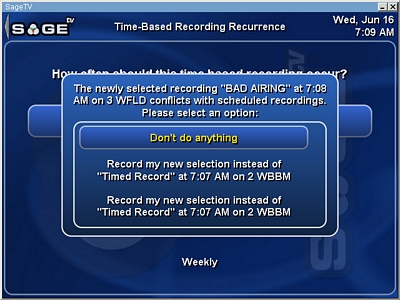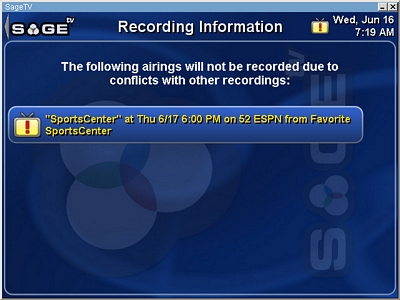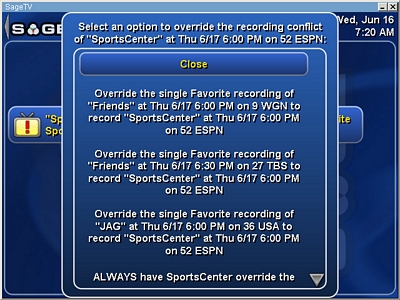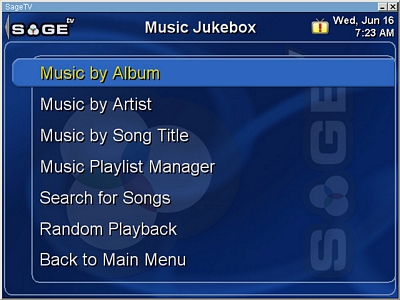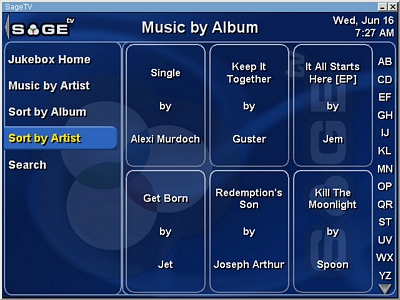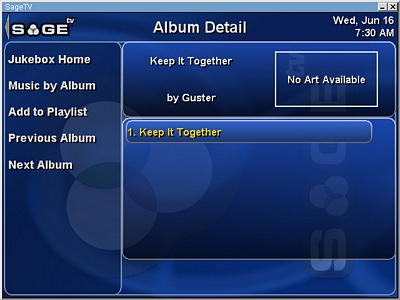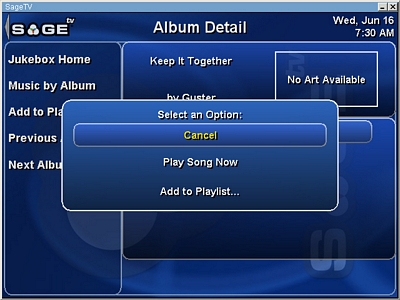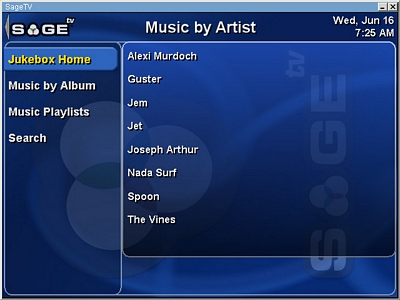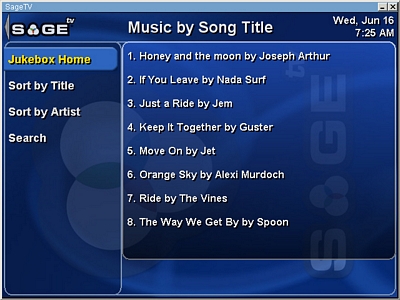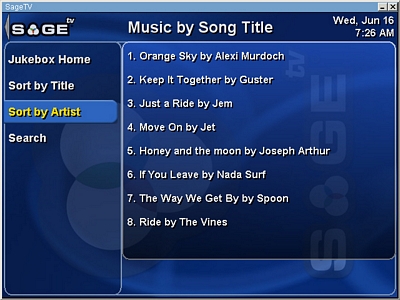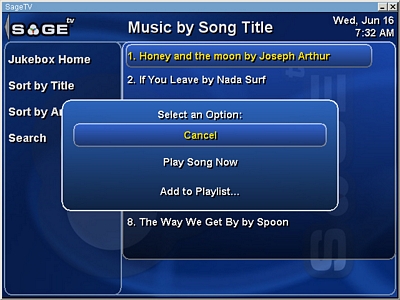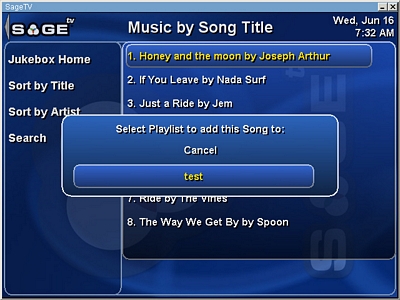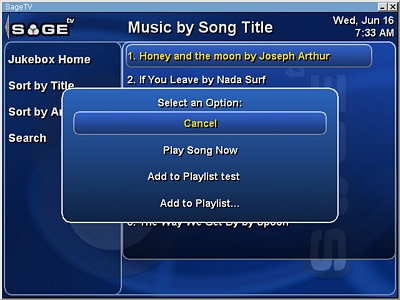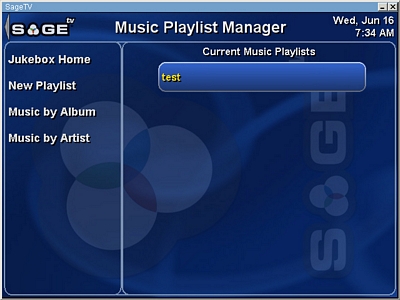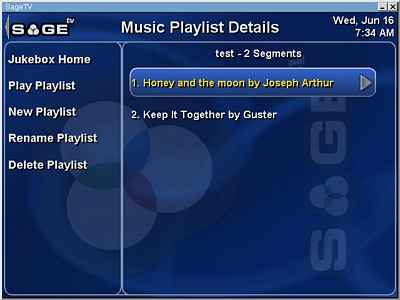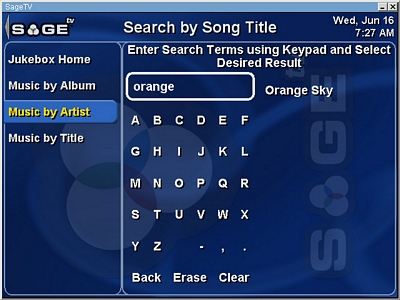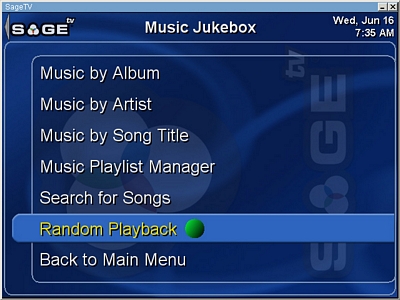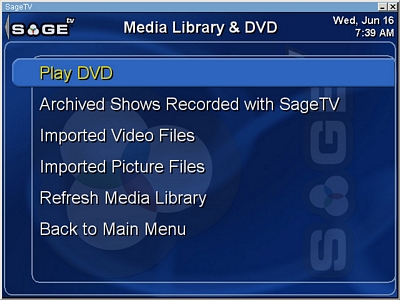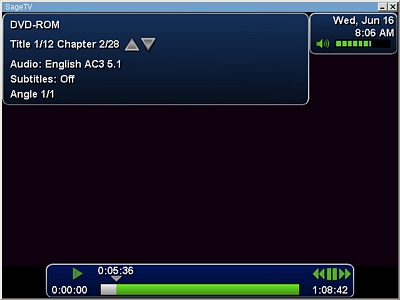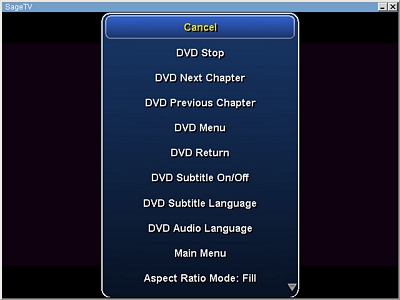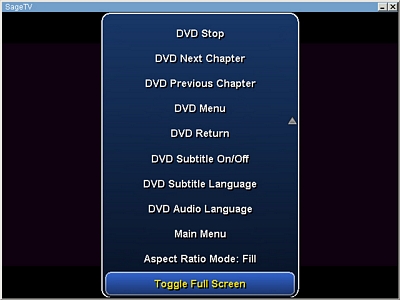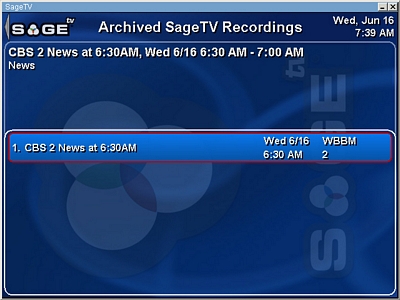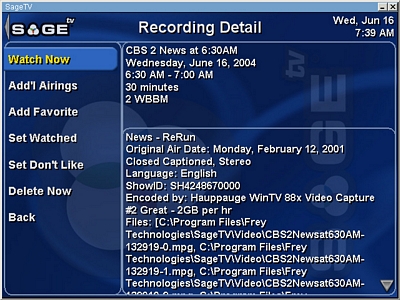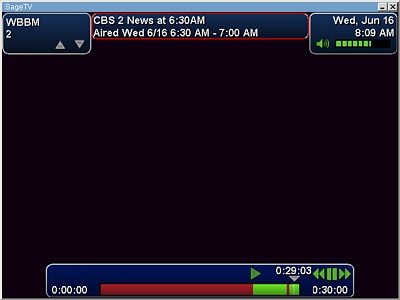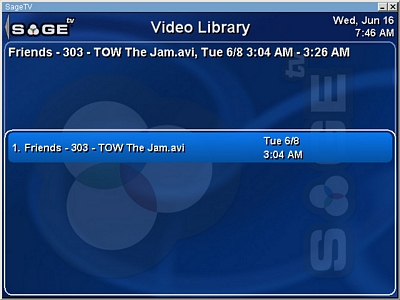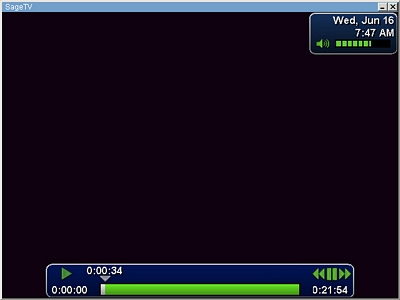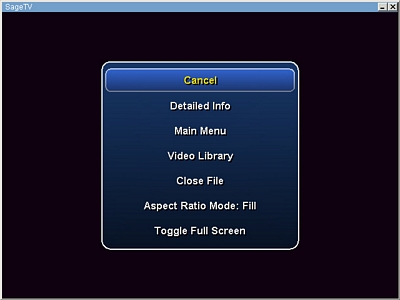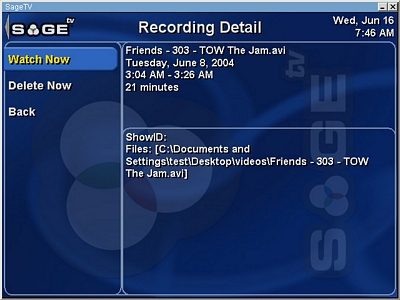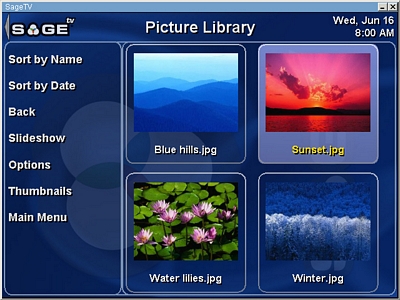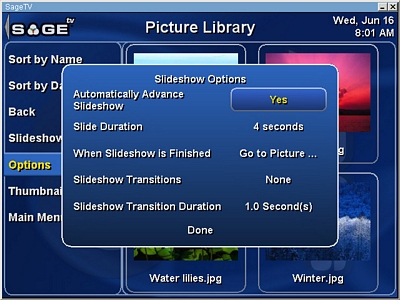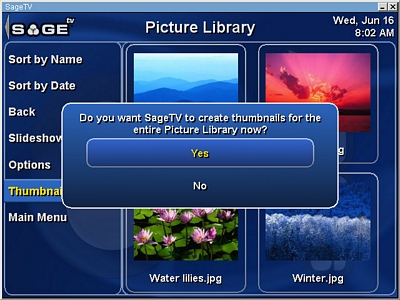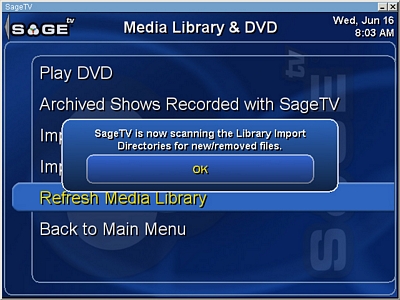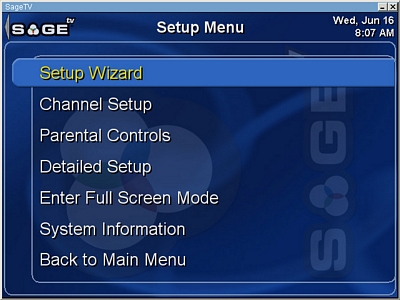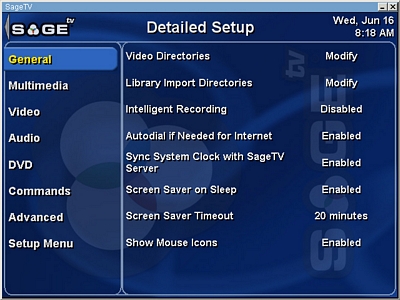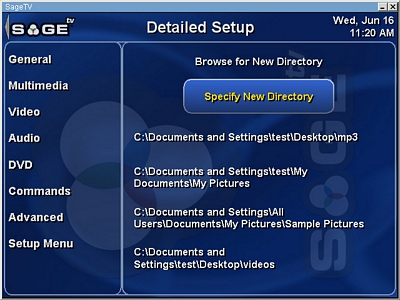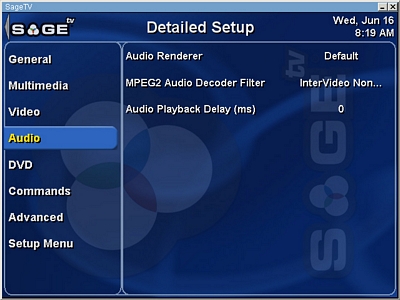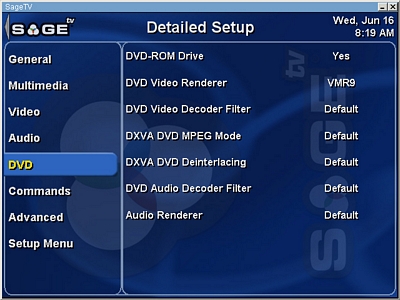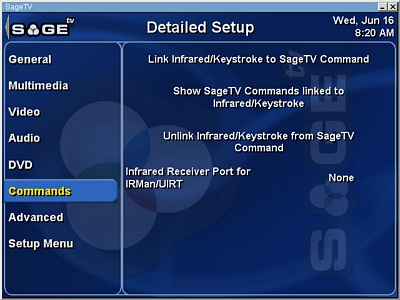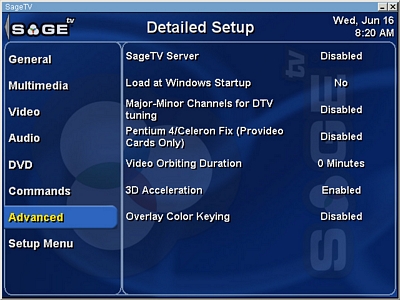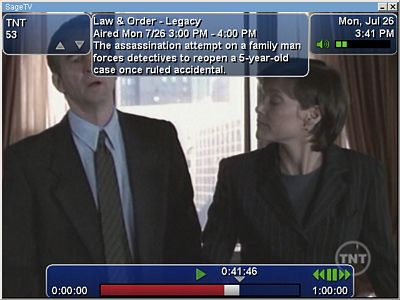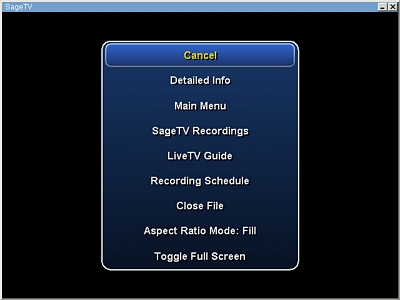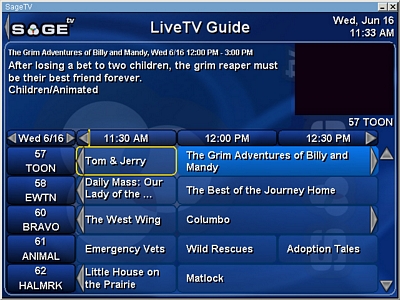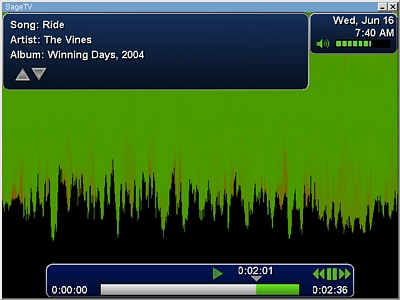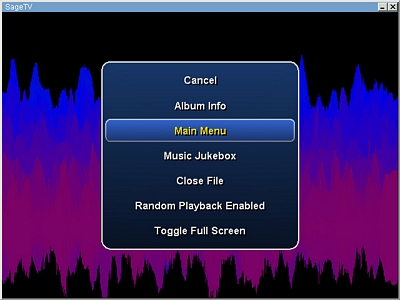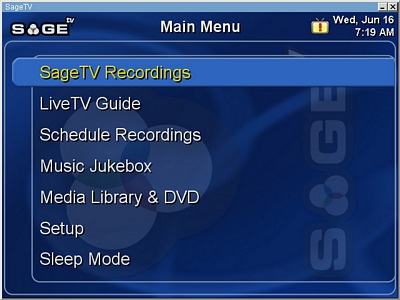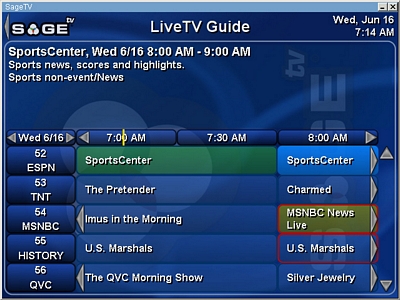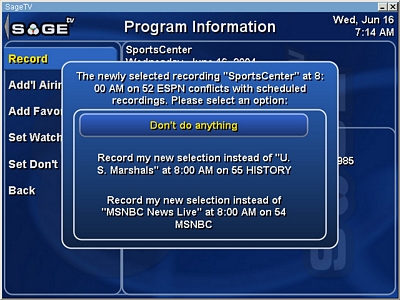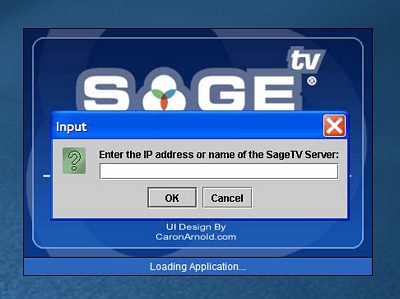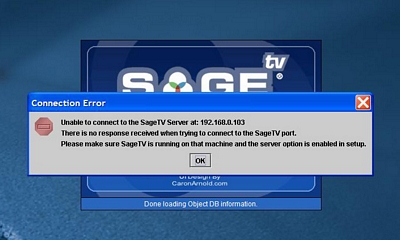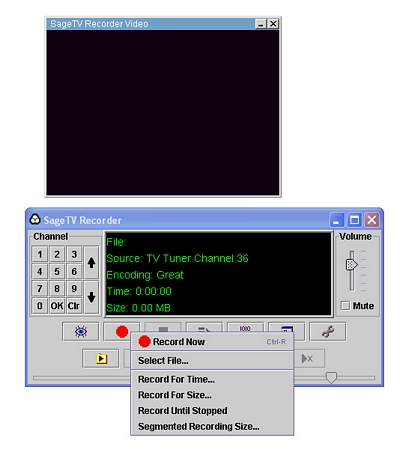
Original Link: https://www.anandtech.com/show/1403
Frey Technologies' SageTV 2.0 - A SnapStream Alternative
by Andrew Ku on July 25, 2004 12:05 AM EST- Posted in
- Smartphones
- Mobile
The great thing about SnapStream's Beyond TV 3 was that it enabled the creation of a HTPC without the need to purchase an entire system to get some of the functionality of Windows XP Media Center Edition 2004 OS. Its limitation was that the program only provided the TV experience and left out things like a music/media/photo library, playing DVDs, FM tuning, and everything else that Windows XP Media Center Edition 2004 brought to the table along with the TV experience.
We have seen and tried lots of MCE imitation software (i.e. InterVideo's Home Theater), but nothing so far has come even close enough to making a great impression on us. Since the last time we checked, Microsoft is maintaining that they will not release MCE 2004 as a direct-to-end user product, which means until they do, there will need to be someone to fill the gap. And with the dropping costs of computer components, people are finding new ways to use their old/spare computer parts, and a HTPC for the home entertainment system answers that need well; either that or spending at least $800+ on a MCE 2004 system. While the hardware requirements needed for HTPCs aren't the same as the latest and the greatest, software continues to be an issue. After all, your HTPC needs to be just as good as TiVo and with more features, if it is going to be worth sinking some of your hard earned money into one.
Aside from SnapStream, the other name popping up in HTPC talks is Frey Technologies' SageTV 2.0. After we finished taking a look at SnapStream's Beyond TV 3, several of you asked for a SageTV 2.0 review, and we are here to deliver.
The Test
Frey's supplied us with the SageTV Multi-Tuner "Blackbird" Bundle w/ Remote, priced at $256.95, which consists of two Hauppauge Roslyn WinTV PVR cards, SageTV 2.0, SageTV Client 2.0, SageTV Recorder 2.0, and a StreamZap remote. We aren't exactly sure where the Roslyn card fits in with the rest of the WinTV PVR cards by Hauppauge, since it isn't presented as one of their consumer products, which means that it is likely an OEM solution.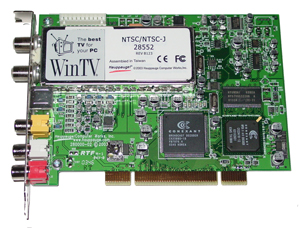
Roslyn PVR card
Click to enlarge.
So far as we can tell, it is basically identical to the WinTV-PVR-250BTV, an off-shoot of the WinTV-PVR-250 card for SnapStream's Beyond TV. Both closely resembles the WinTV-PVR-250MCE and seem to be an OEM/noncompliant MCE version of the WinTV-PVR-250MCE card. Whether or not the WinTV-PVR-250BTV and Roslyn WinTV card use different ASIC IDs, we don't know. The only significance in mentioning this is that the drivers for both cards can't be downloaded off Hauppauge's support site.
Since it looks like we are going to be doing multimedia networking stuff for a while to come, we have standardized our multimedia network with D-Link LAN, 802.11b and 802.11g equipment, which consists of:
- DI-624 2.4GHz 802.11b/802.11g Router
- DGS-1008D Gigabit Switch
- DCF-660W 2.4GHz Wireless CompactFlash Card
- DWL-122 2.4GHz 802.11b Wireless USB adapter
- DWL-120+ 2.4GHz 802.11b Wireless USB adapter
- DWL-G120 2.4GHz 802.11g Wireless USB 2.0 adapter
- DWL-G650 2.4GHz 802.11g Wireless Cardbus adapter
Installation and Setup
Frey Technologies is a smaller company compared to SnapStream and is more community driven than the latter, which is why SageTV is only available via download. There are three components to the SageTV software suite: SageTV 2.0 - $79.95, SageTV Client 2.0 - $29.95, and SageTV Recorder 2.0 - $19.95. Incidentally, they are all sold as separate components and there isn't a three-for-one price option available from Frey's online store. We were sent the SageTV Multi-Tuner "Blackbird" Bundle w/ Remote, which did come with all three components on the included CD, but the SageTV Client and Recorder 2.0 were both trial versions.Before you jump ahead and buy the software, we would strongly recommend that you read up on the requirements. In all, Frey's product requires a Pentium III 600MHz/Athlon 600MHz/VIA 800MHz or faster, 128MB system memory (256MB minimum), graphics card with overlay support, and a TV tuner/MPEG-2 encoding card. Because the TV tuner needs to have a MPEG-2 encoding support, Frey takes a very different approach in software support, since SageTV 2.0 is supposedly ready for non-hardware encoding capture cards, but Frey essentially turns off this feature, with no plans to turn it on soon. This means that NVIDIA's Personal Cinema, ATI's All-in-Wonder/TV Wonder cards, and a plethora of other TV tuner cards can't be used with SageTV. At first we thought that Frey was not using Windows Driver Model support (aka WDM), due to our scrubbing around in the driver files, but Jeff Kardatzke (the coder of Frey) tells us this may be due to the implementation of newer driver model that Frey might be using.
Since the MPEG-2 encoding is done via the encoding chip on the TV tuner, it relieves the CPU of the burden, which is why Frey's CPU requirement seems so low. Personally, we would feel more comfortable raising the requirement of the CPU to a low speed 1.XGHz Pentium 4 or Athlon XP with 256MB of system memory, if the system built is also intended to function as a personal PC. If it is supposed to function as a dedicated system next to your projector or TV, Frey's requirements probably will suite your purposes just fine, but a Pentium III and Athlon right in the sub-1GHz range is probably going to fit the bill better than a 600MHz one. Even though the MPEG-2 chip takes care of encoding, the amount of operations performed on a HTPC that are needed to load software and timeshift are still numerous, and if you plan to watch Divx encoded media (SageTV only records in MPEG-2), our original P4 or XP recommendation is a must.
Broadband internet access isn't a requirement nor is it a major necessity for SageTV. The only time that SageTV 2 uses an internet connection is when it connects to the Zap2It service to download EPG listings, which coincidentally is the same service used by Microsoft for their Windows XP MCE 2004 OS. While Beyond TV 3 and SageTV 2 are both designed to function as a TV server, SageTV 2 is not designed to be accessed outside the local network, though hypothetically, VPN should work, but the throughput consistency of the streamed content will be severely limited by download/upload bandwidth of the ISP and the ISP's routing capabilities.
Installation and Setup (cont.)
Installing SageTV 2 is self-explanatory; the only thing that is worth mentioning is that there are additional finles needed for Provideo 256 capture cards and the Hauppauge PVR 250/350/USB2 IR Remote Control.Once you start up SageTV 2 for the first time, you are prompted with the setup wizard that configures the signal source for the capture card. Since we got two tuner cards, we have two configurations to create. Note that even though we have an All-in-Wonder 9600 installed on this computer (functioning as our Beyond TV 3 compliant card and system video card), it doesn't show up in the setup wizard, since SageTV 2 doesn't implement support for non-hardware encoding cards. SageTV 2.0 only supports cards that have hardware encoding capabilities on-board.
Incidentally, Beyond TV 3 can also use accept similar hardware encoding cards, but the use of them negates the TV streaming feature within Beyond TV 3.
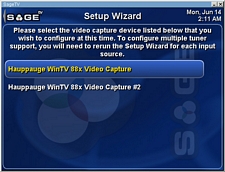 Click to enlarge. |
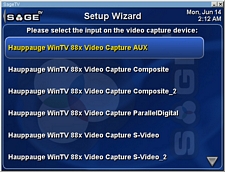 Click to enlarge. |
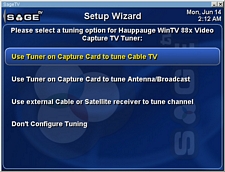 Click to enlarge. |
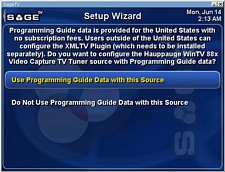 Click to enlarge. |
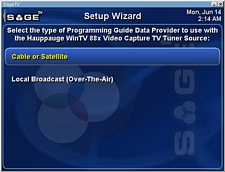 Click to enlarge. |
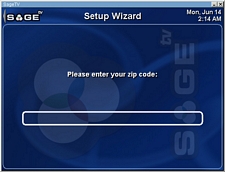 Click to enlarge. |
As already mentioned, SageTV 2 uses Zap2It as its electronic program guide (EPG), which Microsoft also uses in the MCE 2004 OS. Of the four EPG services, we are most familiar with: Zap2It, TitanTV, SnapStream, and GuidePlus+. We are most comfortable with the consistency of the first. After using services for a month, those EPGs using Tribune Media Services (Zap2It/SnapStream/MCE 2004/SageTV 2) seem to have the best EPG consistency that would correctly list TV shows at a specific time, with GuidePlus+ bringing up the rear and TitanTV in tow (in that order).
The reason why we preferred the EPG service of Zap2It and SnapStream the most is that they both take into account the location of the cable feed. If you live within a certain zip code, it is likely that you get your cable feed from an adjacent zip code location where the feed actually is broadcast. For this reason, Zap2It and SnapStream will take this into account and allow you to select a cable feed from the nearby area.
Zap2It is technically the front end for the TV listings that Tribune Media Services provides online. Though SnapStream uses Tribune Media Services, we aren't sure if they use the Zap2It front end (MCE 2004 and SageTV 2 definitely do). Either way, the Zap2It based EPGs in MCE 2004 and or SageTV 2 seem to be more accurate than the one supplied by Snapstream.net for Beyond TV 3. However, the way by which SageTV 2 downloads the listings makes us rank it in the same grouping with SnapStream, since it doesn't display any sort of progress indicator or notify when it is downloading listings. We aren't sure if this is a result of SnapStream using their own servers as a go between, which need to propagate their information from TMS on a frequent basis, but this is our experience.
GuidePlus+ is based solely on a zip code system that has no association with actual cable feeds of towns. Obviously, most people can distinguish their closest town by name easier than by zip code. While TitanTV also associates cable feeds by towns, it doesn't distinguish between the local and distant ones very well. It just provides a plethora of cable feeds from which to select, and because TitanTV is completely web-based, we still would rank the EPG services as such (best to worst):
- Tribune Media Services/Zap2It - Windows XP MCE 2004
- Zap2It - SageTV 2.0/ Tribune Media Services - SnapStream.net(Beyond TV 3)
- Gemstar's GuidePlus+
- Decisonmark's TitanTV
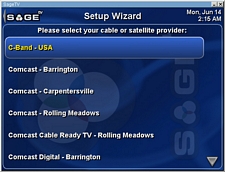 Click to enlarge. |
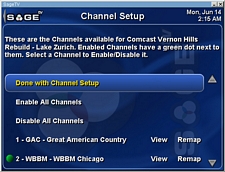 Click to enlarge. |
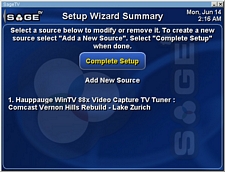 Click to enlarge. |
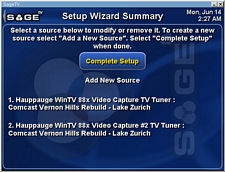 Click to enlarge. |
Getting Started
Compared to others, SageTV 2 seems to take a relatively long time to load, ~ 10 to 15 seconds, even though we were running everything on relatively fast hardware. Beyond TV took us only about 5 to 7 seconds to load, and this might be due to SageTV's use of Java coding or Beyond TV's heavier CPU reliance.Once you load up SageTV 2.0, the main menu interface pops up. In a more MCE fashion, SageTV 2.0 drives all of its features within a single interface. Overall, it is fairly simple GUI, but not necessarily aesthetically appealing or displeasing. Personally, we like the interface that Microsoft did with MCE 2004, with text on one and a nice icon on the other. Frey probably can do the same thing here since there is space on the right side for such.
In terms of features, SageTV 2.0 is not just "TV", though the name suggests otherwise. It can also function as a DVD player and media library (audio tracks, videos, and photos).
SageTV 2.0 - SageTV Recordings
We could have done this review a couple of ways, but we are going to follow our Beyond TV 3 review format, where we navigated and explored the interface in succession of the way features were listed. First up is SageTV Recordings (we will take a look at creating a recording in a bit).The SageTV Recordings submenu displays the recordings in progress and already completed. The listings of the recordings is a factor of priority, not the tuner, which means that "Fox News at 6" is not necessarily being recorded by tuner #1.
If the recording is already completed, these are the options presented.
Sometimes there is an error in the recording. If this is the case, there will be a recording error option that will notify you and allow you to delete it.
SageTV 2.0 - LiveTV Guide
Once you enter the LiveTV Guide, you get a screen that displays the television listings for 5 channels concurrently. We would prefer to see some of the left over space above the guide grid used to display more channel listings (i.e. 7 channels like MCE 2004). Currently, it will only display the program name, date, time, episode title, description, and category, but there is still a bit of room to spare.Shows already recorded and those in progress are outlined in red, and those selected as "set watched" from the options of the program are listed in italics.
Interestingly enough, SageTV 2.0 provides a lot more EPG data than Snapstream's BTV3, which we will get to in the "schedule recordings" section. For now, we can say that Snapstream could pick up a few things from Frey Techologies.
Programs outlined in white are designated as favorites, while those in black are those "set don't liked" via the options of the program. Setting a program as favorite does it for all of its concurrent TV listings, and also sets it to record. Setting a program as disliked automatically removes it from the record list, even if it is listed as a favorite. The disliked variable is specific for a program at a specific time, and not all of its listings. This is why a favorite program that is also set as disliked is outlined in black.
Favorites already recorded and in progress of being recorded will be changed to a white outline when the recording time passes or hits.
Once a program is programmed to record via the record button, the button name changes to "record options", and selecting it will bring up recording options.
If the record command is given for a program that is not currently playing, then there will be different record options. Recording a program that is currently playing will use the default recording quality selection.
SageTV 2.0 - LiveTV Guide (cont.)
Selecting additional airings for a program will list all of its concurrent TV listings, even if it is on different channels.Setting a program as a favorite does it for all of its future listings. Because of this, Frey's product provides lots of options to control the way in which it records.
Selecting the "set watched" and "set don't like" buttons changes the fields to clear options. As already mentioned, programs set as "watched" are listed in italics and "don't liked" in black outline in the livetv guide.
SageTV 2.0 - Schedule Recordings
Going into the schedule recordings submenu brings up several options to help manage programs to be recorded.The upcoming recording schedule is fairly straightforward, but it is difficult to navigate in practice. We would rather see the listings done as an actual list with programs occupying a single line as "SageTV Recordings" format. Scrolling and scrolling to navigate to a specific favorite program to designate "not to record" isn't that easy.
A list function can be viewed, but it is not the default view and can be switched by going into option (right click) and switching the "schedule display" option from "parallel" to "interleaved." The effect is the same as the view for "additional airings" or "search results" for a query.
The search function that SageTV has implemented is extensive and well thought out. Searching for a title or a person can be done with partial phases and everything entered is automatically treated as a wildcard variable. But you can't enter "brother band" to get "Band of Brothers", since the queries of phrases are done alphabetically.
We randomly entered in "mark", and SageTV provided a bunch of entries, and as you can see, "mark" is treated as a wildcard query. This is the way it should be done, which is something that SnapStream needs to do with Beyond TV 3 or future iterations of their software.
Note the detail of the information for the show, while not completely shown. SageTV 2.0 provides more EPG data for programs like sitcom episodes: actors are listed, language, director, etc... All the stuff we are used to from MCE 2004 and a bit more. This can be seen when you go into "program details" for that particular program.
Searching by description and/or all fields is treated a bit differently. Entered queries are treated as whole words and are not considered wildcard entries. We can't enter Monica and Chandler to get Friends listings, where Chandler comes after Monica in the program description.
SageTV 2.0 - Schedule Recordings (cont.)
The favorites manager provides more of an overall way to program recordings, since everything designated as favorite is set to record by SageTV 2.0 unless it is set as "don't like".Adding a new favorite by title and actor bring up a search screen, which follows the same principles as the search for programs to record by title or actor.
Favorites can also be designated by their genre, but it is hard to get the right one down because action listings are sometimes listed as adventure or suspense and so on.
Timed recordings can also be created, but the way in which the UI is laid out is a bit hard to navigate. SageTV seems to be going for a horizontal layout, and the channel selected should be directly left of the start time. Thus, we would like to see the center channel always selected with the arrows used to navigate to the correct channel.
Plus, the arrows between the select channel and select start time and select start time to select stop time should actually function as buttons, which would navigate you to the field to the right. The last arrow button is correctly assigned to finalize the timed recording.
If there is a recording conflict, SageTV 2.0 will prompt with a window to select the overriding program. In this case, we tried to create another timed recording on channel 3 at the same time as the first one created for channel 2.
If there is a recording conflict, an icon will appear in the upper right hand corner next to the date and time. The icon also serves as a button that will navigate you to the recording information screen that will list all recording conflicts. If not resolved, the other programs that have been selected first will record and SageTV 2.0 will discard the last one created; in this case, "SportsCenter".
SageTV 2.0 - Music Jukebox
The Music Jukebox lists all audio media that has been added via the detailed setup menu.We just added a folder with a few MP3s and went into the SageTV 2.0 music by submenus. Music by album will display 6 albums at once with the album name and artist within each album icon. Navigating to a specific album can be done via the alphabetical tabs on the right hand side or using the arrows above and/or below the letters.
Album art is supported by SageTV, but it must be supplied by the user via Musicmatch or some other third party software. Frey Tech doesn't download it for you.
The screen for music by artist is much cleaner and we prefer this to the way the music by album listings are done, as everything is much more organized.
SageTV 2.0 - Music Jukebox (cont.)
Listings music by the song title displays audio tracks in a similar format as artists with an added number system. The numbers are just for listing purposes and do not serve as remote control assignments.It is possible to add a track multiple times to a playlist, but once you hit play playlist, SageTV 2.0 will sort out the same track entered in multiple times into a single entry.
The search function for all the music submenus brings up a search by song title screen. It basically follows the same principle as the search by title or actor screens. Everything entered is treated as a wildcard query, but each phrase entered is searched for alphabetically, so "sky orange" won't bring up "orange sky".
Selecting the random playback button brings up a green icon within the field. This random playback applies to all music played assuming it is not done within a playlist, since audio tracks are sorted by priority in the playlist.
SageTV 2.0 - Media Library & DVD
The media library is just like the music jukebox in the sense that only media in the folder specified in the detailed setup will appear within SageTV 2.0.Playing a DVD is done via this submenu, but we would prefer to see it on the main menu rather than this one. It just seems more suited in that location because of the way people play DVDs. Plus, we would count DVD a category apart from the media library. Note that popping in a DVD doesn't autoplay, which is the way it should be for a PVR platform.
Playing a DVD brings up a window similar to playing audio tracks and watching TV. The bar on the bottom displays the track slider that displays time elapsed and total time, which can be moved by selecting a point within the bar. The white bar indicates the portion already watched and the green indicates the portion left. The arrow designating the spot being currently played cannot be used to navigate to a specific point.
The play, pause, backward, forward, and volume/mute are all interactive. But the backward and forward buttons need to be held down to function as rewind and fast forward commands, but SageTV 2.0 doesn't allow you to do a factor by rewind or fast forward (i.e. 2x, 4x, etc.).
Finished recordings are listed in SageTV recordings, but the listings can become cluttered after a period of time, which is why there is a move to library function. Once moved, you lose options like record error, etc. because you are chosen to approve it to your media library.
Watching an archived recording file brings up a screen similar to live TV, with a few exceptions. Since this recording entry is technically corrupted, there is a red bar indicating the major missing portion and the white portion of the bar is the segment being currently played. If SageTV 2.0 encounters problems during a recording, it automatically restarts the recording within another file, which is why there are multiple segments for a single recording. Recordings are named specifically for program and episode being listed and that file name functions as the show ID tag.
Going into the video library lists all the videos that are in the library specified folders. We threw on a DVD rip of a Friends episode that is Divx encoded. Playback is supported for Divx encoded media so long as a Divx codec is installed.
Playing a video file brings up a more simple screen. There is no upper left hand window that displays the name and other file information.
SageTV 2.0 - Media Library & DVD (cont.)
The Media Library also supports pictures and going into the picture menu brings up a 4-thumbnail view of pictures in your library's folders.While the number of thumbnails cannot be changed, the way slideshows appear can. We would like to see a removable media function because adding media only by folder is a hassle if it can only be done via the setup. Removable media is all but common now, especially with digital cameras, and for a MCE replacement system, it is important to have this function.
SageTV 2.0 - Detailed Setup
The Setup Wizard and Channel Setup are the same as in the setup process when the program first starts up.The detailed setup submenus provide all of the major and minor functionality behind SageTV 2.0. If you get a chance to turn Intelligent Recording on, it is a bit of a treat for all those in lazyboys. When enabled, SageTV records and manages programs automatically based on previously watched programs, marked watched, marked disliked, things deleted, things you recorded, favorite settings, recordings already on disk, and what you are watching vs. watching other users are watching on the network. This is the 3rd generation of the SageTV Intelligent Recording AI, a pretty smart one at that and is probably one of the best features of SageTV 2.0. Because your habits are stored in a database as part of a reference point for the AI, you can retain the data by keeping the wiz.bin file in the SageTV directory for a reinstall or upgrade. This file contains all the database information for SageTV, including the information for the AI to base its decisions on.
Adding a library import directory is fairly simple, but there is a general principle by which it follows. Any folder selected will automatically include subfolders, regardless of depth as far as we can tell. But any folder included will not include any shortcuts of media files or shorts of folders under folders included.
Via the multimedia settings, you get live tv/video/visualizations to act as the background, while you continue to navigate SageTV 2.0; this option can also be changed by right clicking in any of the menu environments.
SageTV 2.0 - Watching TV and Playing Music
Watching live TV brings up a simple window. The upper left hand corner window displays the station name, channel name, and two-channel navigation arrow. The show name, air date, and show description are displayed in the upper middle window with the current date/time, and volume in the upper right hand window. The volume icon doubles as a mute button and you can interact with the volume track. All of these panels autohide themselves after a few seconds, but this amount of time between the autohide feature doesn't seem to be able to be edited.All TV that is watched is timeshifted, and this option cannot be changed. The TV displayed in the window is actually about 1 second behind the live signal, and the difference in time noticed, if you put the two side by side, is minimal. From the time that you hit the "watch now" button to actually watching the live TV signal, it is about 2 to 3 seconds, which is reasonable as we like a maximum of 3 seconds when dealing with auto-timeshifted content.
If you have already started to watch a program or programs, the last program being watched will be displayed in a small window within the show detail windows and LiveTV Guide. The window itself is an actual engageble object that can be navigated to, but only within the show detail windows. If you are watching "Tom & Jerry" and click on the window, it will go to the show. However, going into another program's show detail and clicking on the window will automatically change the channel to that program (assuming it is currently on) and switch back the full window mode.
Getting to the full window mode of playing music can't be done directly via the music jukebox, but rather by hitting the back button in the upper left hand corner a few times. Visualizations are automatically on and visible during playback, but they cannot be manipulated in the setup. Like the live TV interface, the panels autohide after a few seconds.
SageTV 2.0 - Conflict Management
Conflict management within SageTV 2.0 is straightforward. Whenever this is an issue, an icon will appear in the upper right hand corner next to the date and time. Clicking on this icon will bring you to the Recording Information screen under the Schedule Recordings submenu.Straightforward conflict management is easy, as SageTV 2.0 just prompts with a window to override one of the currently scheduled recordings in favor of the new one or just cancel the new recording.
Putting the program into sleep mode is basically reducing the program to run within the system tray. Passing the cursor over it will display the programs/episodes being currently recorded. If there is a conflict, the SageTV 2.0 will be replaced by the conflict icon. And clicking on it will bring the SageTV 2.0 window up to the main menu location, with the conflict icon still showing in the upper right hand corner.
 Click to enlarge. |
 Click to enlarge. |
SageTV Client 2.0
The SageTV 2.0 client is almost exactly the same as the interface for the server, minus a few details. First, loading the SageTV 2.0 client prompts you for the IP address of the server, which almost always needs to be entered. In the detailed setup section on the client side, you can store the IP address that the client should always be pointed towards. Keep in mind that if the server crashes the client will simply seek out the server until told otherwise, with the prompt mentioning something like "connection with server lost, trying to reestablish connection." If the server is not running when the client starts, the client will wait and continue to seek the connection to the server until told otherwise.Other than entering the IP address, you can hardly tell the difference in the actual UI, except the server option in the detailed setup. There are several setup options that are sharing, meaning that by changing the variable on the client, it will also change automatically on the server and vice versa (i.e. recording quality).
Note that your client still needs an MPEG decoder for it to view the TV stream from the server. Management of which tuner that clients feed from is automatic, and we found no conflicts in our use of several clients in turn with the server. Each feed takes about 6 Mbits of bandwidth, so a typical 10/100 should easily handle a multi-tuner server and several multi-tuner clients.
For the sake of things, we ran the client on our newest Dell Inspiron 8600 (1.7GHz) with ATI MR9600, and we found things to be a bit slow. It seems that the program is heavily software decoder dependent, since we were able to get smooth playback once we installed and selected Cyberlink's MPEG2 decoder in the detailed setup.
It is interesting to note that a client can actually setup a TV tuner and media to share with the rest of the network. Setting up a TV tuner is basically the same as doing it on the server, and the server automatically manages the tuners on the various clients. If a client requests a signal, the server arbitrarily distributes TV feeds from different TV tuners. If the client-to-client scenario is used, the client with the tuner first feeds the signal to the server and then the server to the client without the tuner. Because of the multilinking, there is an additional 1-second delay in the client-to-client scenario versus server-to-client.
Adding a folder in the library on a client will do so for the whole SageTV 2.0 network, which is a big plus if you have plenty of media to share on multiple systems.
Note that each client needs its own license key because once the client links to the server, it occupies that key, and any other computer on the network attempting to use that key will be locked out. If a key needs to be transferred, Frey's SageTV does provide a way in their tips and tricks support page.
SageTV Recorder 1.5
While we have SageTV 2.0 on the table, we decided to take a look at the SageTV Recorder 1.5. It is basically a simple interface to record TV. The SageTV Recorder can also be configured to record from a tuner on another computer, either a client or server running SageTV, but there is quite a bit of configuration that needs to be done for it to work. This review is going to get very long without having to write some of what Frey has already made guides for, so read Frey's guide. Keep in mind that once it is configured to record from a network source, it will need to be reconfigured to record from a different network source.While, technically, there is currently no license checker protocol in the recorder, you are still suppose to have a separate license key for each computer using the SageTV Recorder.
Final Words
During the initial testing portion of our review, we had several issues with creating a stable multi-tuner Roslyn SageTV 2.0 server, and at no time, did we have the same issues as with Beyond TV 3. For whatever reason, there was a hardware conflict that we were not able to track down. We notified Frey of the issue and were told that they were working on it. Apparently, it has been limited to new hardware, since they haven't encountered the issue until now. Before we even contacted Frey, we were swapping in and out P4 motherboards, memory, video cards (from old MX to 9800s), as well as tweaking various BIOS settings (i.e. HT), to no avail. The odd thing was that we were actually able to predict when SageTV 2.0 would crash, and if we followed a specific procedure, we could cause the system to be semi-stable until the next system restart.If we set a program to record then watch another program, we get a blank screen on the second program selected. The first program selected is correctly displayed with the feed coming in from the Roslyn card in the lowest PCI slot. If we set a program to record, then record another program, and then select the second recorded program to watch, we would get a SageTV 2.0 crash. If we repeat this last step, sometimes we would get the multi-tuner environment to work, but it didn't work all the time.
When we went to a single tuner per system (server or client) environment, everything was fine. We don't have that many tuners compatible with SageTV 2.0 floating around in the labs, but we were told by Frey that this problem was limited to multi-tuners systems using Roslyn cards. Recently, Frey issued a fix via a new .dll file and posted it in their forums as well as recompiled their installation .exe for SageTV 2.0.20, and you probably should try V2.0.20 first as Frey recommends. So, we went back to SageTV 2.0 and tried our hand again at two Rosyln cards in a multi-tuner state, and voila, it worked! After several days of testing, we didn't seem to have any of the issues that we noticed with our past use.
Though, as recently as yesterday (7/24/04), Dan Kardatzke (Frey's President) mentioned that there are problems with Roslyn cards and SageTV 2.0's auto-brightness settings. While we did not encounter multi-tuner problems with the fix for Roslyn cards, we did notice a few a few odd things in terms of brightness compared to some of our other cards (read about some of the specific issues in their forums). Dan and Jeff Kardatzke (Jeff's the coder) plan to phase out the bundles that include Roslyn cards and replace them with another card in the upcoming few weeks. So what you see in the future may not be referred to as "Blackbird" something bundle.
As a MCE 2004 replacement, we find that SageTV 2.0 takes a lot of serious strides, but it still has a lot of work before it catches up completely. As we already mentioned, the UI is not necessarily displeasing or appealing, more neutral than anything else. This is even more so for the TV window, audio playback window, or video playback window. The information windows like the track slider, volume, etc. are blocky and don't integrate well with the TV environment. As a MCE alternative/TiVo replacement, there needs to be a better flare for the aesthetics, something just as important as the functionality, which Frey has pretty much down.
We have been told by Frey's that SageTV 2.0 is coded on a structure that supports skins, and we have been told and seen that some of SageTV 2.0's users have "hacks" that mimic the MCE 2004 to the teeth. However, Frey's doesn't support their use in these sense that they don't provide support if the skin doesn't work as said, but they will provide support if the skin "damages" the core functionality of software. Keep in mind that a skin is kind of two parts: the user interface and the functionality (i.e. a skin can add new functions like looking up weather). Any support provided by Frey for skins beyond this is done on a case by case basis. This is one users' series of skins skin sample 1, sample 2, and sample 3 (user's website). At the moment, we see SageTV 2.0 as a product for the couch potato enthusiast, a crowd for which we would limit our recommending this product to. For them to cross to the mainstream crowd, there needs to be more UI development.
Personally, we can take a program and understand everything about that program, including "cheats" and shortcuts, within less than an hour without any need for a manual. With Beyond TV 3, we did exactly that, but with SageTV 2.0, it was a bit of a challenge to understand how everything works. And for those with our same tack for programs, we still recommend that you read up on the tips and tricks section in Frey's support section for SageTV 2.0 and/or read the Readme file a bit more thoroughly the first time around.
If you are looking for a really easy way to watch TV, we would recommend Beyond TV 3. It is a no fuss program that supports many more TV tuners on the market than SageTV 2.0. If you are creating a TV server that has clients that will still function as personal computers, Beyond TV 3 is still the way to go. There is no charge for additional clients and virtually any computer, so long as it supports windows media player, and can watch streaming TV. Clients alone as a XPC stationed next to your TV/projector in your living room don't work well as a TiVo replacement, since streaming TV content and remote recording almost always require a keyboard. A SageTV 2.0 server is probably more practical in this sense, and there is no limit to the number of servers that you are able to put on your local network, as long as you purchase a license key for each system.
If you want a multi-tuner multimedia server, SageTV 2.0 is the only way to go at the moment, though SnapStream says their new BTV 3.5 version (scheduled for release in about a month or so) features multi-tuner support and BTV networking clients in addition to TV streaming over IE, called BTV Link (which should be like SageTV 2.0 server client setup). The problem that we see with SageTV 2.0 is that you need to continuously pay for additional clients or configure clients to use the key purchased and the restrictions imposed on supported tuners. As a multimedia server or client, it functions great as a basis for an XPC stationed in your living room, though StreamZap's remote still doesn't give have the same functionality as we can get with Remote Wonder and Beyond TV 3 (you can use Remote Wonder with SageTV 2.0 via a supplied plugin on Frey's website).
Either way, both Beyond TV 3 and SageTV 2.0 (server, client, and recorder) are available as trial versions with no particular usage limitations other than time, which is why we would heavily recommend that you try out each one if you are having a hard time deciding between the two. Though, if you plan to get SageTV 2.0, you might as well wait till the new bundle phases in.
We have been hearing some good things about SnapStream's Beyond Media, which supposedly is SageTV 2.0's true competitor, but until we get it in-house to judge, the only MCE alternative that actually gives similar features is SageTV 2.0. It is one thing to provide an alternative to MCE 2004, but it is quite another thing to provide an alternative just as good as MCE 2004. Though we will admit, Microsoft could probably pick up a thing or two from this little guy (i.e. Intelligent Recording). Frey is having things a bit easy, since competition to fill the gap is virtually nil, but with SnapStream joining the fray, we hopefully should see more solid and well-honed products from both companies.

